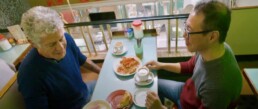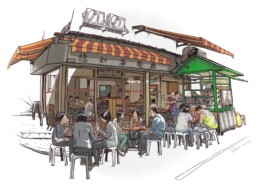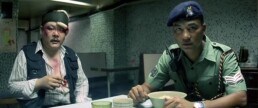Serving up a rarely changing menu of quirky Canto-European treats, the much-loved cha chaan teng is at the heart of the city's cultural identity.
WITH A FIFTH WAVE of the Covid-19 pandemic washing over Hong Kong, all restaurants in the city have been ordered to pull down their shutters by 6pm. Daytime business in the city’s cha chaan tengs has mostly remained brisk, however. The quirky, no-nonsense cafes have long served up affordable staples to busy people needing to get in, chow down and get out in a hurry.
The cha chaan teng — or “tea restaurant” — is the Hong Kong equivalent of the “greasy spoon” cafe, or perhaps the American diner. Frequented by everyone from tough construction workers and sharp-suited bankers to slumming celebs craving the cheap dishes they were brought up on, cha chaan tengs offer a rarely changing menu of what has been called “soy sauce Western food”: lowbrow, sometimes bizarre but always comforting East-West hybrid fare that fuses the thriftier ends of the culinary traditions of two very different worlds.
Modest but popular cha chaan teng dishes include fried eggs and spam in macaroni soup, sweet-pastry chicken pies, Hong Kong-style spaghetti bolognese and baked pork chop rice (a not-so-secret ingredient often used in the latter two: ketchup), often washed down with strong black tea enriched with canned evaporated milk.
All are delivered superfast by cranky, harried staff in stark, egalitarian surroundings. Think Formica tables and foldout stools, bathroom-tiled walls and retina-searing strip lighting.
TO UNDERSTAND THE origins of the cha chaan teng one must look to when Hong Kong was under British colonial rule. In the years after the Second World War and with revolution in China, refugees flooded into the territory seeking respite from conflict and poverty. Between 1945 and 1951 alone, Hong Kong’s population swelled from 600,000 to more than two million.
The menu preferences of Mayfair and Manchester had long been available in Britain’s far-east possessions, but the full-service European restaurants serving up such treats were prohibitively expensive for most Chinese.
While life was tough for many in Hong Kong, there was, however, work with a burgeoning manufacturing industry, notably in textiles and toys and other plastic goods — and the opportunity for social mobility. Many profitable China businesses — and their cash — had also fled cities such as Shanghai to continue operating from the more stable British outpost.
“Western food became popular first with the wealthy Chinese and then eventually with the poor, who saw it as something exotic, although not necessarily delicious”
Susan Jung, food and drinks editor, South China Morning Post
By the late 1950s, with incomes rising and tastes becoming more adventurous, Hong Kong’s working-class diet became increasingly influenced by European customs.
“Western food became popular first with the wealthy Chinese and then eventually with the poor, who saw it as something exotic, although not necessarily delicious,” says Susan Jung, food and drinks editor at Hong Kong’s South China Morning Post newspaper, and who has covered the local dining scene for more than 25 years.
Milk was occasionally added to tea, Jung says, sometimes to be accompanied by cakes, sandwiches and other foreign confections. And so the cha chaan teng was born, characterised by Canto-European concoctions that have variously been described as eccentric, weird, even trashy.
“The food they serve is certainly unique and much of it came about through British colonisation, when they brought ingredients, cooking methods — such as baking — and dishes that the local Chinese were unfamiliar with,” says Jung.
Such dishes common to pretty much every cha chaan teng today include satay beef macaroni, curry-sauce chicken wings with crinkle-cut chips, fish chowder and fluffy scrambled egg sandwiches — always using the cheapest white bread and often with the crusts neatly cut off, as with English afternoon tea.
“British custard tarts changed to Chinese egg tarts,” says Jung, adding that Borscht, the vegetable soup initially introduced to China by anti-communist Russians fleeing revolution in their homeland for Shanghai in the early 20th century, and then to Hong Kong with revolution in China, remains popular in cha chaan teng. “But now the red tinge in the soup comes from tomato, not beetroot.”
WHEN ANTHONY BOURDAIN swooped into town to shoot an episode of CNN’s Parts Unknown in 2018, the New Yorker and his crew dropped by China Cafe, a family-run cha chaan teng first opened in the densely populated neighbourhood of Mong Kong in 1964.
Bourdain went for the noodles with spam and fried eggs in soup, and the sai do si, or “western toast”. Preparation of this artery-clogging delight, Jung explains, can vary greatly with the cha chaan teng. “Usually it’s two slices of cheap white sandwich bread layered with peanut butter, then dipped in egg and fried,” she says. “It’s then topped with butter, golden syrup and sometimes condensed milk.”
Bourdain also sampled a pineapple bun — a cheap cha chaan teng snack that, Jung reveals, actually contains no pineapple. “It’s an unfilled bun with a sugary, crumbly topping that is supposed to be scored in a pattern that resembles the markings of a pineapple, but many places don’t bother with that anymore,” she says. “It’s especially delicious when you have the pineapple bun split in half, with a thick slab of cool butter inside. It goes wonderfully with hot or cold milk tea, depending on the weather.”
And when youthful Hong Kong democracy campaigner Joshua Wong was interviewed for the Financial Times’ regular “Lunch with the FT” slot, with Hong Kong’s anti-Beijing protests about to reach their dramatic peak in November 2019, it was no surprise that the PR-savvy activist pulled up a plastic stool at Tak Yu Cha Chaan Teng — a popular-with-the-people cafe hidden away in a down-and–dirty Wanchai backstreet.
Wong coupled his fried rice with a cup of Hong Kong-style milk tea, which is a silky and aromatic cha chaan teng specialty. “As you can probably figure out from the price of a cup [usually US$2-3], the tea leaves aren’t the best quality, so preparation is very important in making a good milk tea,” says Jung, explaining that the Hong Kong drink is brewed strong and filtered several times — often through a long, stocking-like strainer — to make it smoother.
“Smoothness is the most important part of good milk tea. It shouldn’t be coarse or astringent,” she adds. “It’s served with evaporated milk, which also smooths out the tea and makes it richer than it would be with fresh milk.”
Yuenyeung means “mandarin duck” in Cantonese … The fact that the male duck and the female duck are so different in appearance is supposedly echoed in the harmonious mixing of the tea and the coffee
Peculiar drinks are central to the cha chaan teng experience, says Jung. Other popular beverages include yuenyeung, an acquired-taste concoction made from two-parts milk tea and one-part black coffee. Yuenyeung means “mandarin duck” in Cantonese, the bird being a symbol of conjugal love in Chinese culture. The fact that the male duck and the female duck are so different in appearance is supposedly echoed in the harmonious mixing of the tea and the coffee.
Then there’s hot Coca-Cola with lemon and ginger, and hot water with raw egg and sugar, and 7-Up with lemon slices marinated in salt (good for a sore throat, apparently). And Horlicks, and Ovaltine, and a mix of Horlicks and Ovaltine. And hot Ribena with lemon, and cream soda with milk, and “red bean ice” — a signature cha chaan teng drink contrived from sweetened red beans, evaporated milk, vanilla ice cream and crushed ice.
WITH THE LOCAL Cantonese cuisine also native to nearby Macau and China’s neighbouring Guangdong province, the cha chaan teng is arguably Hong Kong’s only unique dining experience. Though there are now such cafes in the Chinatowns of Singapore, Bangkok and other Southeast Asian cities, as well as in Canada, the US and the UK (any place where Hong Kongers converge in numbers, in fact), the reliable cha chaan teng is at the heart of the city’s singular cultural identity.
Travellers to Hong Kong frequently make a beeline for the most iconic cha chaan teng, with Instagram-favoured Mido Cafe in Kowloon’s Yau Ma Tei neighbourhood perhaps the most popular, its unaffected, retro interior pretty much unchanged since the 1950s. Now, however, like so much of what makes Hong Kong special, the cha chaan teng is in retreat, with numbers gradually declining as a result of climbing rents over the past decade (China Cafe shut up shop in December 2019).
As early as 2007, in fact, Hong Kong lawmaker Choy So Yuk saw a need to preserve the city’s cha chaan tengs, proposing to the local legislative council that the cafes be put forward for inclusion on Unesco’s Intangible Cultural Heritage List. Her proposal came about after a Hong Kong poll found that seven out of 10 Hong Kong people believed their favourite cafes did not enjoy the recognition they deserved. “Even many mainland [Chinese] tourists do not know cha chaan teng,” Choy said at the time.
They will, however, have likely seen them many times before on screen. Very few Hong Kong movies or TV dramas are without at least one scene shot in a cha chaan teng, with Mido Cafe providing a nostalgic backdrop in outings ranging from Wong Kar-wai’s seminal Days of Being Wild to the brilliantly named Revolving Doors of Vengeance.
China Cafe, meanwhile, proved a moody location for Johnnie To-directed action flicks PTU, Election and Fulltime Killer, as well as for gooey romance Endless Love and zesty comedy Once Upon a Time in Triad Society.
But in the end, the cha chaan teng was not added to the UN’s illustrious list, perhaps because of its humble, proletarian and decidedly unglamorous nature.
“Why would the United Nations care about this place?” shrugs office worker Tony, over a rushed breakfast of processed ham and fried egg noodle soup, a cup of steaming milk tea at his elbow, at a bustling eatery on the edge of Hong Kong’s high-rise financial district. “It’s just another cha chaan teng. Hong Kong still has hundreds of them.” ◉
This story ran on the BBC Travel website in March 2022.
SHARE






